Backpacking with Dogs: A Walk on the Wild Side
If you love hiking, have you considered your dog as a companion? Your dog does not have other commitments, eats anything dished up without grumbling and has no problem getting up in the morning, unlike many of your two-legged hiking mates. When backpacking with dogs it is also comforting to know you have a partner whose senses are more acute than yours and will pick up any suspicious sounds and movements long before you.
[the_ad_group id=”21″]
This could be an unwelcome animal or something more sinister. Let’s face it, these days some trails can be frequented by persons who see hikers as easy targets. They are unlikely to bother you when they notice your protector.
Do you suffer from separation anxiety every time you have to leave your dog at the kennels or with a pet sitter? This happens even when you know and trust the people in whose care you are leaving them. Well, here is an alternative that will make both you and your hound happy.
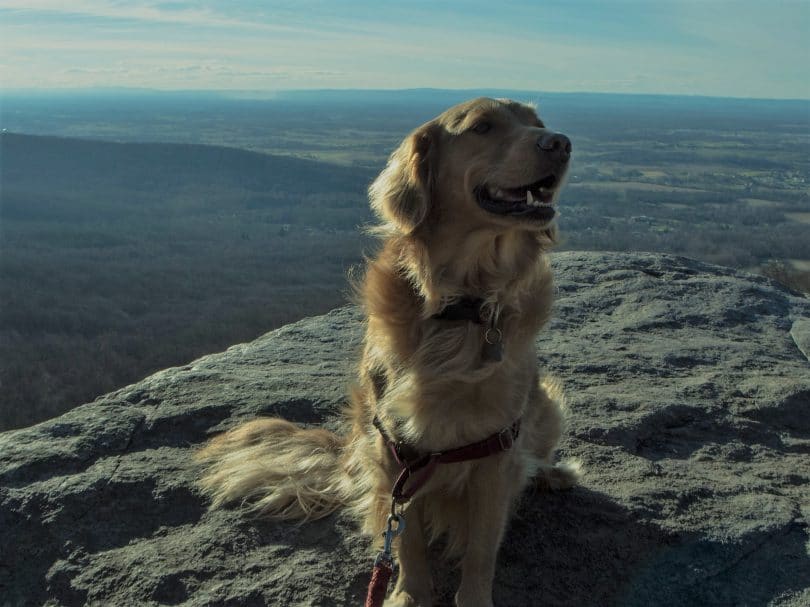
There probably will not be any cost savings for the first trip or two, because you will be loading up on canine hiking accessories, but in the long run this will be easier on your pocket. Your anxiety levels will be lower and as a result, your hike will be even more enjoyable.
Hiking with dogs offers opportunities to people who have previously not been able to go on a hike because they have a disability that requires them to be accompanied by a service dog. If you are in this situation, while a solo hike with your dog is not a good idea, you can accompany a few friends in the company of your four-legged guardian.
Before you rush off with Fido in tow, however, please consider the following advice, so that you can make the most of your canine hike. You will ensure that both you and your dog have a mutually enriching and memorable experience.
Is my Dog the Correct Breed?
While all dogs love a walk, not all breeds are suited to long excursions in all types of weather. Dogs that come to mind are bulldogs and bull terriers – the former can experience breathing problems and all of them overheat and overexert quite easily. Conversely, herding breeds were bred to be out in all climates and have stamina and endurance.
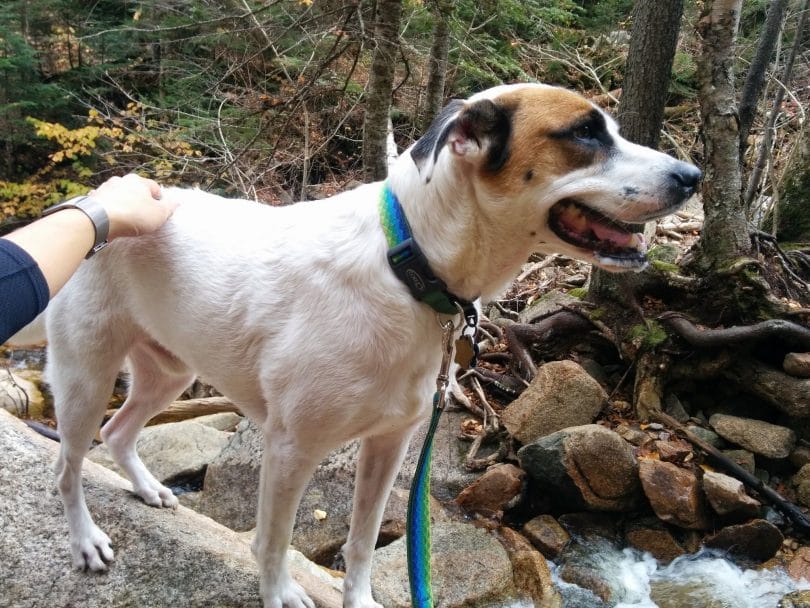
The acid test is based on your dog’s fitness and what they can cope with currently when it comes to walking and running. If they are not that fit (which implies you are not that fit either), you can start some mutual training to build up stamina. Another breed characteristic to consider is temperament.
Age is a factor as well – a dog that is younger than 2 or older than 8, we do not recommend hiking with your dog. Check with your vet though, he can assess the dog’s fitness.
Does my Dog have Good Trail Manners?
If your dog is very “busy”, like a Brittany, or bred to be protective, like a Malinois, they might make other hikers uncomfortable. Remember, not everyone likes dogs and some people are really scared of them. Your dog should be well trained and obedient, responding to commands like “Sit”, “Stay” and “Leave”. You must be in control of your dog at all times.
If you have never taken your dog for formal training, it is recommended that you do – you will also get an idea of how your dog reacts to unusual situations and different surroundings. Explain to your trainer that you intend taking your dog on a hike so that your training can be geared towards doing just that (yes, it’s you who needs training, the dog not so much).
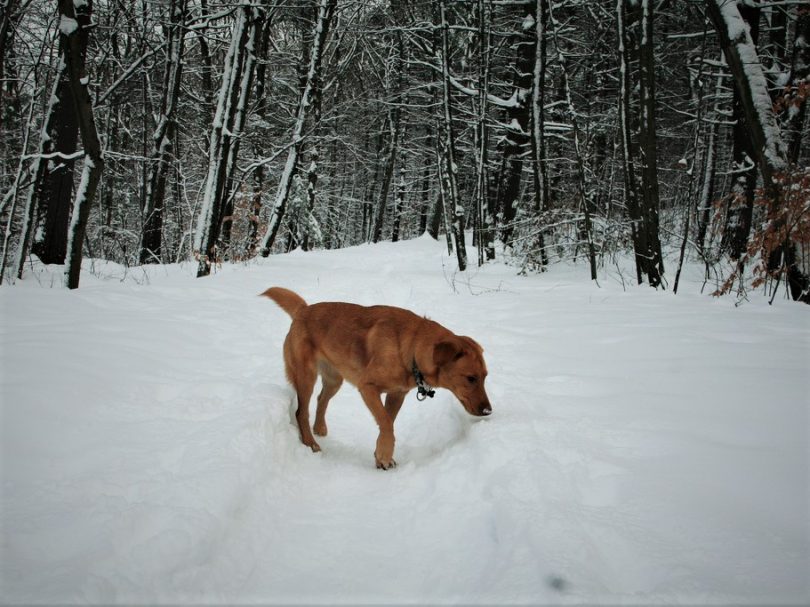
Obviously, if your dog is aggressive, it is not a good candidate for a hike. Dogs that bark at every twig that snaps and every leaf that falls are also going to be very unpopular, even with you. After all, the silence of nature, punctuated only by birdsong or running water, is one of the main attractions of backpacking.
Two’s Company, Three’s a Crowd
No matter how many willing and able dogs you own, you can only take one with you. If you want to take more, enlist some hiking friends in the ratio one human: one dog. This is because firstly your dog will be leashed and walking multiple dogs on leashes is something only the Argentineans have mastered. Secondly, blazing down a narrow trail with a pack of hounds will not be looked on favorably by other hikers, even if they like dogs.
Planning for the Hike
Here is where you have to do all the work, planning and provisioning are not on your dog’s CV. You can opt to be the beast of burden and carry all your dog needs, or you can share the load by investing in a doggy backpack. If you do get a pack, you will have to acclimatize your dog to it first. If your dog already does carting this may not be a big deal. Check out some of the best dog backpacks in our earlier article on this important topic.
Another essential, if you have not already done it, is to microchip your dog. In the unlikely event that you get separated, the microchip will do much to ensure a happy ending; collars and tags can get lost. You should, in any case, do this, this is the best way to trace ownership of a stray or stolen pet.
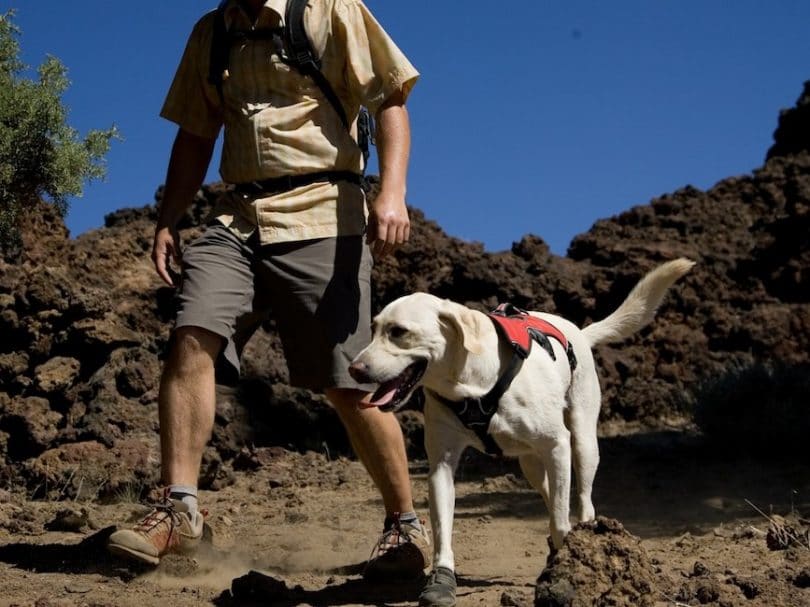
When and where to Hike
This depends a lot on where you are based and the local regulations and climate. Some trails are accommodating and some do not allow dogs, except possibly service dogs. There are places where the weather can be very fickle, with freak snowfalls or heatwaves.
If you belong to a hiking club, they may have list of dog-friendly trails. Alternatively, search for a book on the subject for the area you plan to visit. Make sure you understand the restrictions on hiking a trail with a dog – some parks do not allow dogs to stay overnight, but they are allowed in for day trips.
Ideally, you should stick to spring or fall – you do not want to cope with a blazing midday sun or heavy snowfalls, while dogs love to play in the snow, an extended walk in icy conditions is not such fun, especially for long-haired dogs, who get clumps of snow tangled in their hair and it is a mission to get them out. A hairdryer is good, but obviously not an option out in the wild.
You should also consider whether it is high or low season. When the trail is packed to capacity with other hikers, hiking is not such fun, especially if you are a solitary person. When you have your dog with you, you will be doing a lot of stops to let others get past, or find it hard to pass yourself because of large parties of hikers.
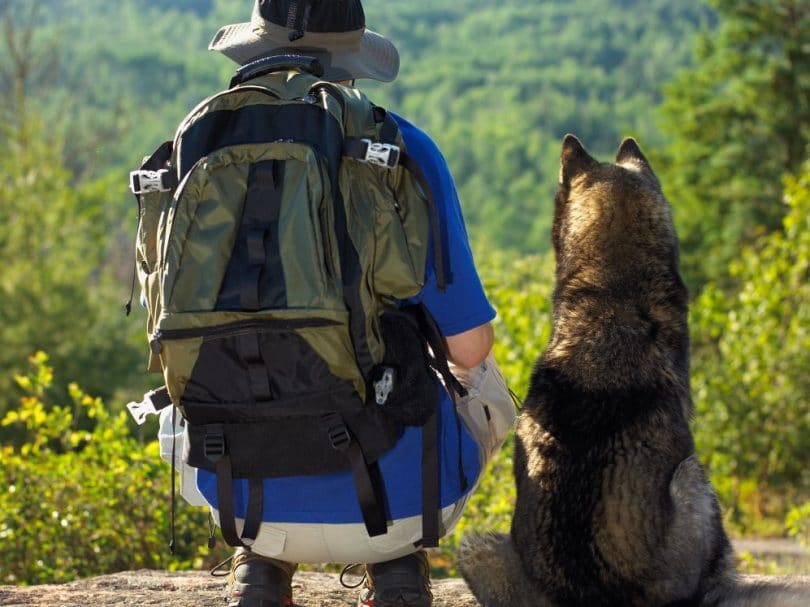
The only problem with opting for the low season, is that it takes you out of the best hiking times, when the weather is temperate. You will need to balance between avoiding the crowds and being exposed to tricky weather.
Maintaining a Cold, Wet Nose – Keeping Healthy
Obviously, the last thing you want is for your dog to be poorly, or to become so out of sorts that you have to cancel your trip. This involves preparing for anything that could affect his health. If you use a tick and flea remedy like a dip, a spot treatment or a pill to be ingested, make sure that you apply a dose a fortnight before you leave.
[the_ad_group id=”22″]
Some of the topical applications require that the dog does not get wet several days before applying and several days after. If you use a collar, dump the old one, unless it still has a lot of wear in it, and put on a new one.
If you prefer to use natural protection, be extra vigilant in the mornings and evening and comb through or examine the dog’s fur to make sure there are no ticks lurking.
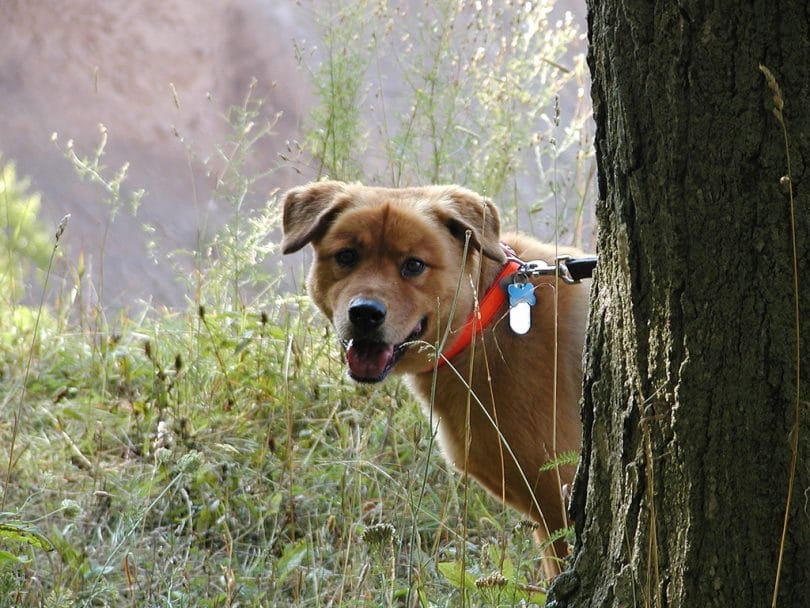
If you do not know canine first aid, consider taking a course and investing in a first aid kit. You will be able to impress your friends with your ability to perform a Heimlich maneuver on a dog! Seriously, though, if your dog needs treatment when you are miles from wherever you parked your car, you will be the only healthcare specialist around. Another tip is to locate the closest vets to the park/hiking trail you are visiting and keep their number and address on you.
You will be scooping much poop along the way, so pack accordingly. You may have to carry the waste for some time before you can dispose of it, so maybe a separate pouch or accessory for holding the filled bags is a good idea. Strictly speaking, you should treat your dog’s waste the same way you do yours. If it is possible to dig a hole to dispose of it (not always the case), you can do that too.
Coping with Anxiety and Fear
You are taking your dog into an alien environment. Chances are it will love every moment, but it might also feel ill at ease and anxious. In addition, many dogs fear loud noises and storms. If you do not already have a thundershirt or practice Tellington-touch bandaging, we recommend that you start doing so before you go hiking with your dog.
Using a thundershirt or even a big crepe bandage has a great calming effect on a dog in any situation that makes it nervous, especially noisy events like storms and people letting off fireworks. It calms your dog (with a few exceptions) and as a result, your anxiety is reduced too.
What to Pack for a Canine Adventure
Here again, this is your job. Your mutt may bring you a few toys to add to the pack, but that is the limit of his contribution.
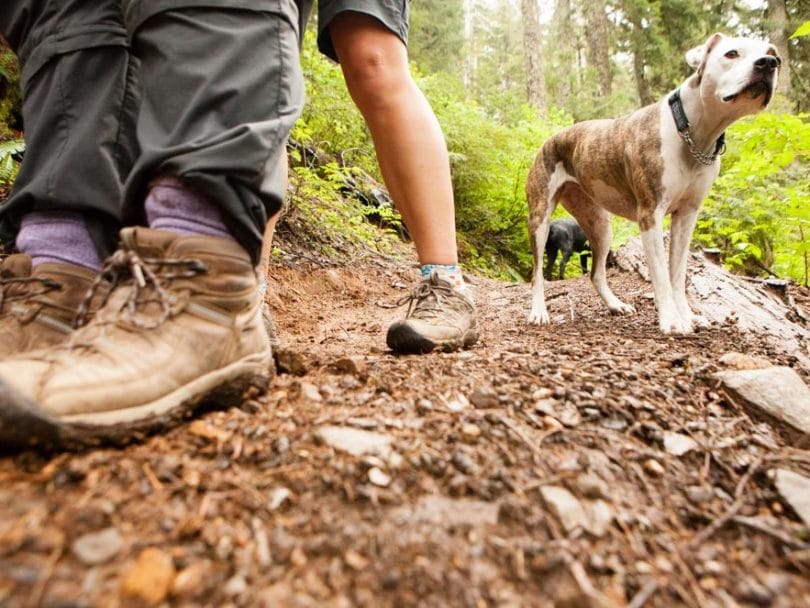
Water – We discuss water later, but you must ensure that you will always have enough water for both of you.
Food – You are both going to be expending extra energy and therefore you need to pack your dog’s normal food allowance, plus another 20%. If you normally feed your dog once a day, consider changing to a morning and evening meal. This is better on the trail, as in the evening your dog might feel too tired to eat, while he will be hungry in the morning. Here are 2 tips about dog nutrition, especially if you are feeding kibble:-
- Do not feed your dog immediately after exertion. Wait at least 15 minutes until your dog has cooled down. This avoids the risk of an intestinal torsion.
- When the weather is hot, you should cut the amount of food down by 30% This is because the kibble might not be digested properly when it is hot, and it can ferment in your dog’s stomach.
Don’t forget some treats, either as rewards or as bribes, where the situation occurs.
Accessories, Protective gear and Bedding – If your dog is used to raincoats and booties, by all means pack them. It takes a long time for dogs to accept wearing booties, you should start when they are pups. If you are keeping to a trail, the path should present hazards that make the wearing of booties necessary (unless there is ice and snow).
Pack a spare collar and leash, in case the current ones snap. don’t forget your long leash. The dog’s collar must carry all identification and health tags required in your location. Take a copy of the dog’s vaccination certificate as well.
If your dog normally needs a blanket at home, pack a blanket for sleeping on. If your dog normally sleeps on your bed – tough! he could be at the kennel! See our top backpacking dog bed for the needs of your pooch.
Hiking with Dogs – On the Trail
If you have prepared well, there will be few issues that arise when you are actually on the trail. Remember, you are an advocate for dogs being on trails, so your behavior, and your dog’s, must be exemplary.
- Obey the trail rules
- Be considerate and an ambassador
- Remove all waste promptly. No-one wants to step in doggy-doo
- Stand aside to let others pass, telling your dog to sit when doing so.
- Always keep your dog leashed. We will explain why.
Joined at the hip – leash at all times
We know that dogs love nothing better than to run free and unfettered. This does not work on a hike. Keep your dog on a leash that is no longer than 6 feet, and preferably 3 feet long.
Why this is necessary? You are in unknown territory – your dog could go bounding along and fall over a cliff or into a ravine. Depending on where you are hiking, there could be snakes and other dangerous creatures. What if a skunk crosses your path? Remember the “Leave” command? This is why you need it!
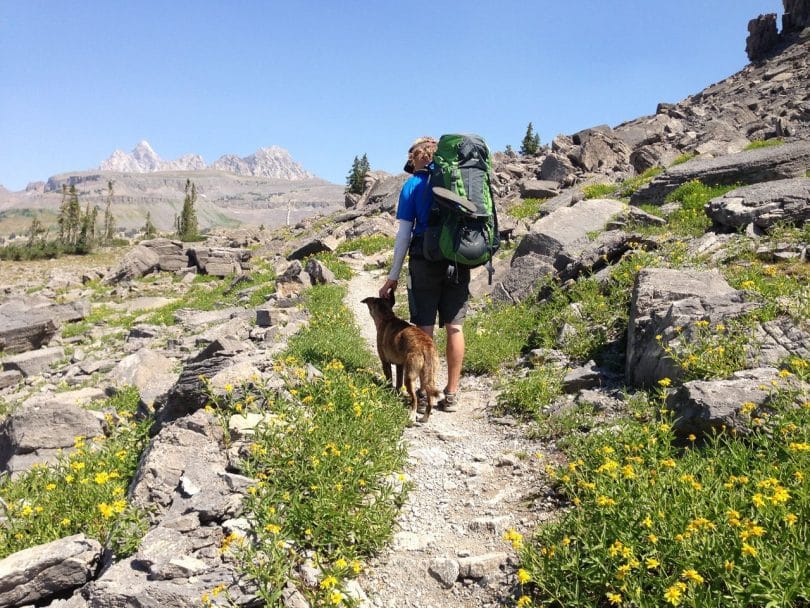
Also, if your dog is on a leash, you will know when and where there is poop to remove. Even overnight, you should ensure that your dog is not loose. If it wanders off in the middle of the night, it might get lost. For daytime and night-time stops, you can replace the short leash with a long-running leash, so that your dog is free to sniff around and explore the immediate vicinity.
If you do get separated (e.g. the leash or collar snaps) and your dog runs off, just stay where you are. Your dog is better equipped to find you than vice versa. You can also ask any hikers who come past if they have seen him.
Water Management – Hydration, River, Lakes and the Sea
Keeping yourselves hydrated
Water is the most important thing for you and your dog on the trail. Make sure you always have water available. Be extra vigilant about your dog overheating and/or dehydrating, and what quality of water they ingest.The rule is:-
- If the water is not good enough for you, it is not good enough for your dog either.
- If you normally carry water, you will have to carry extra for your dog; this can work on a trail which has regular watering points where you can refill your containers.
- If you rely on a filtration system, filter your dog’s water too. Dogs are not immune to giardasis.
Ideally, your dog needs small and frequent drinks throughout the day. You should have a small drinking bowl to provide the water. There are canine water containers that combine a bottle and a small container. However, make sure your dog will drink out of this before you take it with you.
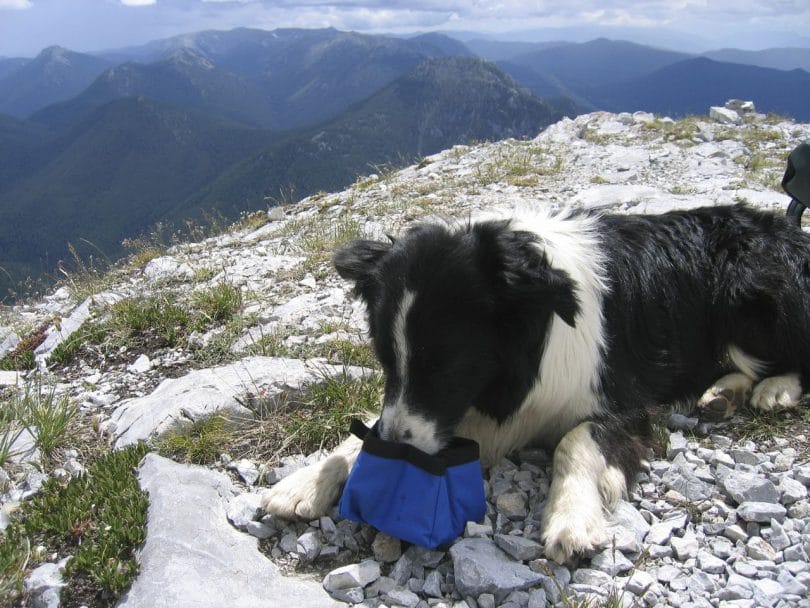
Bodies of Water
Some dogs are uninterested in water; some live for plunging into it, especially when they are hot. If you have a water baby, you will have to take care that they don’t get into difficulties. While most dogs are sensible and approach unfamiliar water cautiously, there are those few that just go flying in.
[the_ad_group id=”23″]
If your dog wants to swim, we recommend putting it on the long leash and reeling it out slowly. If there are branches in the water that it can snag on, then you don’t want your dog in that water. You may have to deny your dog the pleasure of a swim, if you are not confident about things like rip currents, but better safe than sorry.
The Joy of the Trail – Creating Great Memories
We hope you have not been put off by all the cautionary advice. If you are a dog-lover, you know that all the planning and preparation will be worth it. Your greatest reward will be that happy canine by your side. For every hiker who resents dogs on a hike, there will be several who will enjoy seeing your dog by your side. You will probably have far more conversations with strangers than you ever have when walking with other hikers.
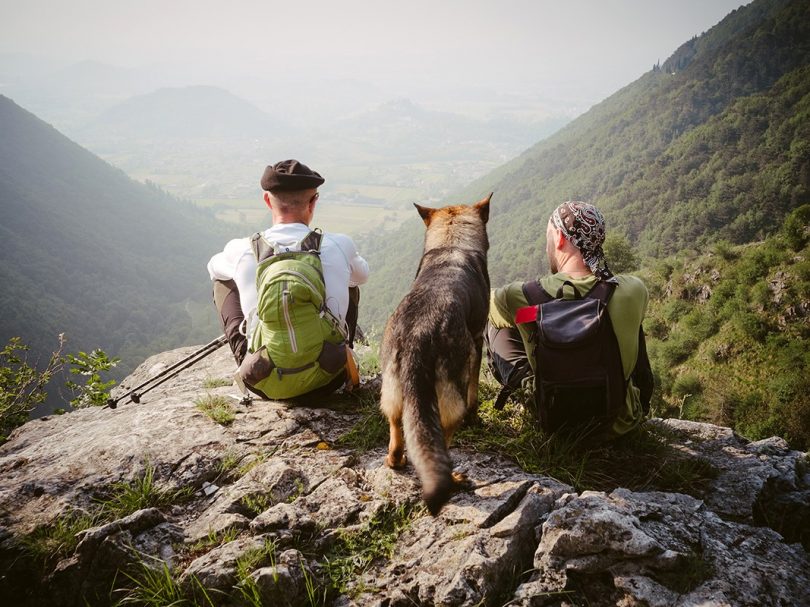
We hope you take a camera so that you can get some great selfies of yourself and your furry friend. When he is old and gray and too old to take to the trail, you will be able to recall the fun days you had. Now you have the time and opportunity to make those memories – what are you waiting for!
Do read our expert review of the best dog backpacking gear to prepare your dog for an awesome hike!


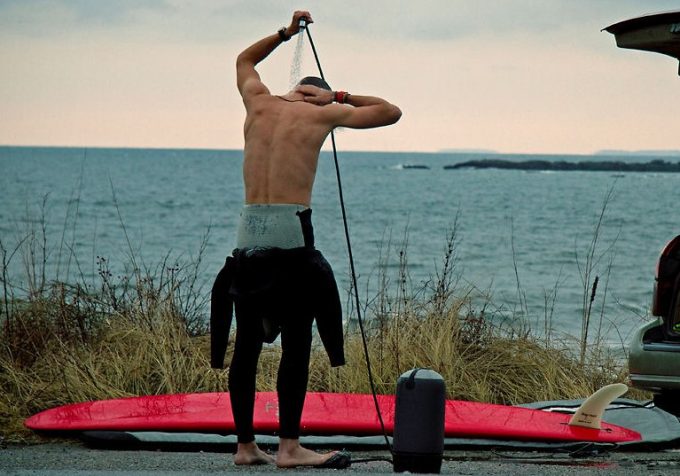
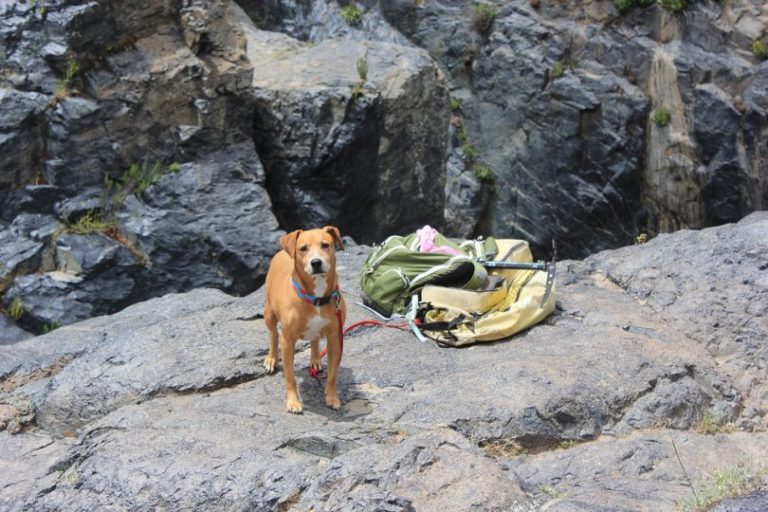

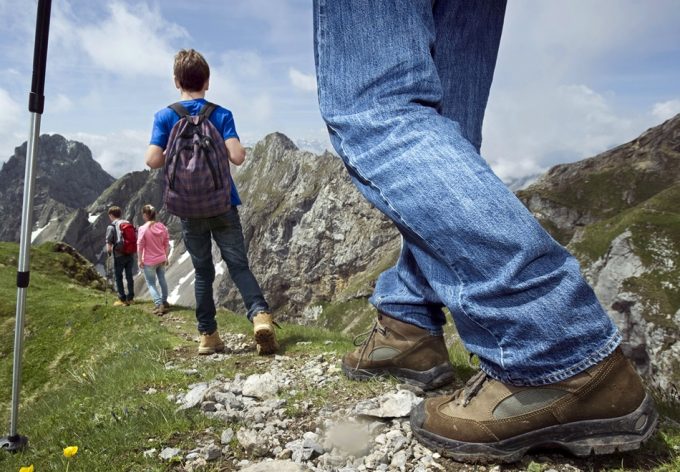
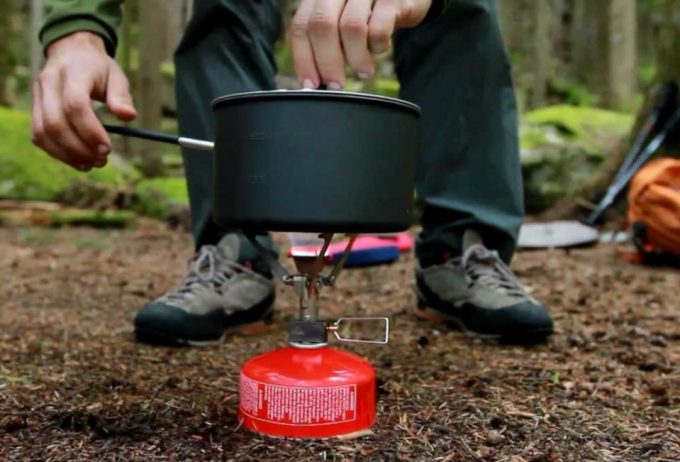
I always thought it would be fun to hike with my dog. He is the least vocal dog I think I have ever known, doesn’t have a mean bone in his body, and is a pedigree mutt. My only issue with taking him is that he gets scared a little too easy and I worry he would have a bad time. I hadn’t thought about packing a thundershirt for him. Do they make thundershirts with pockets so he can help carry some of his food?
Thundershirts were made to be snug fit with no pockets for to keep anxiety at bay. However you can get a separate gear for that so your pooch can carry his own goodies. Check out some of them online and find out what suits you and your dog’s needs.
I always thought it would be fun to hike with my dog. He is the least vocal dog I think I have ever known, doesn’t have a mean bone in his body, and is a pedigree mutt. My only issue with taking him is that he gets scared a little too easy and I worry he would have a bad time. I hadn’t thought about packing a thundershirt for him. Do they make thundershirts with pockets so he can help carry some of his food?
Thundershirts were made to be snug fit with no pockets for to keep anxiety at bay. However you can get a separate gear for that so your pooch can carry his own goodies. Check out some of them online and find out what suits you and your dog’s needs.
I suppose a leash is necessary at all times if your dog likes to wander. Lucy has been hiking with me since her puphood. I had her a hip belt leash when she was younger, now that she is older, she never goes away from my side without asking permission. I guess it just comes down to knowing your dog. Although I understand the concerns with your dog getting spooked or bounding off for adventure, with the right dog, or a well trained one, this is never an issue.
Yes, it is important to have your dog on leash at all times if possible. No matter how well trained they are, it is best to keep them close with a leash as to avoid any unfortunate incidents. Other animals may find their way to your trail and may possibly cause an unnecessary chase.
Yes, it is important to have your dog on leash at all times if possible. No matter how well trained they are, it is best to keep them close with a leash as to avoid any unfortunate incidents. Other animals may find their way to your trail and may possibly cause an unnecessary chase.
I suppose a leash is necessary at all times if your dog likes to wander. Lucy has been hiking with me since her puphood. I had her a hip belt leash when she was younger, now that she is older, she never goes away from my side without asking permission. I guess it just comes down to knowing your dog. Although I understand the concerns with your dog getting spooked or bounding off for adventure, with the right dog, or a well trained one, this is never an issue.
Yes, it is important to have your dog on leash at all times if possible. No matter how well trained they are, it is best to keep them close with a leash as to avoid any unfortunate incidents. Other animals may find their way to your trail and may possibly cause an unnecessary chase.
Yes, it is important to have your dog on leash at all times if possible. No matter how well trained they are, it is best to keep them close with a leash as to avoid any unfortunate incidents. Other animals may find their way to your trail and may possibly cause an unnecessary chase.